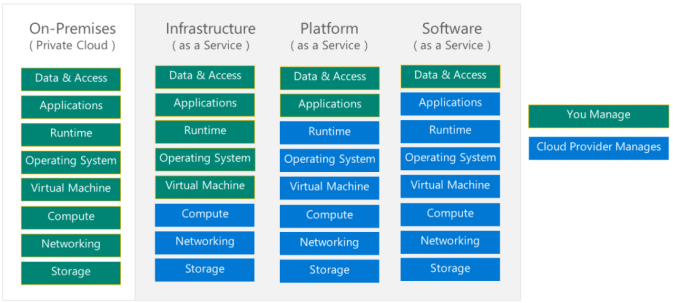Infrastructure-as-a-Service or commonly known as IaaS is the most basic cloud service category. In this, most of the authority is with organization.
In this architecture, Cloud Providers manages Physical Storage, Networking and Compute to the Organizations, Hypervisor, network hardware. Cloud Consumers manage rest of the things like Virtual Machines deployment, Operating System, Runtime, Applications and Data & Access, VNet Configuration, storage provisioning.
Cloud Consumers can use Azure Portal, Azure CLI, Azure PowerShell cmdlets and Azure REST API to manage Azure services.
Users will build pay-as-you-go IT infrastructure by renting servers, VMs, storage networks and operating systems from a cloud provider. it is an instant computing infrastructure that is provisioned and managed over the Internet.
Examples of IaaS: Microsoft Azure Virtual Machine, Azure Storage Account, Azure Virtual Machines that have Microsoft SQL Server installed, Cloud virtual network configurations (VNets and subnets, load balancers, IP Address, route tables)
IaaS characteristics
- Upfront Cost: There is no upfront cost. Users pay only for what they use.
- User Ownership: The user is responsible for the purchase, installation, configuration and management of their own software operating systems, middleware and applications
- Cloud Provider Ownership: Cloud Provider ensures that the cloud infrastructure like storage, network and virtual machines are available for the user.
Common Usage Scenarios
- Migration: This is managed as we manage on-premises infrastructure providing an easy migration plan for moving existing applications to the cloud.
- Test and Development environments: Test and Development environments can be quickly build hence new applications can be developed and testing in a faster way helping them to bring to the market faster.
- Website Hosting: Running websites using IaaS can be less expensive than traditional web hosting.
- Storage, Backup & Recovery: Organizations avoid the capital outlay for storage and complexity of storage management, which typically requires a skilled staff to manage data and meet legal and compliance requirements. IaaS is useful for handling unpredictable demand and steadily growing storage needs. It can also simplify planning and management of backup and recovery systems.
- Web apps: IaaS provides all the infrastructure to support web apps, including storage, web and application servers, and networking resources. Organizations can quickly deploy web apps on IaaS and easily scale infrastructure up and down when demand for the apps is unpredictable.
- High-performance computing: High-performance computing (HPC) on supercomputers, computer grids, or computer clusters helps solve complex problems involving millions of variables or calculations. Examples include earthquake and protein folding simulations, climate and weather predictions, financial modeling, and evaluating product designs.
- Big data analysis: Big data is a popular term for massive data sets that contain potentially valuable patterns, trends, and associations. Mining data sets to locate or tease out these hidden patterns requires a huge amount of processing power, which IaaS economically provides.
Advantages of IaaS
- Most flexible out of three services
- Eliminates capital expenses and reduces ongoing cost
- Improving business continuity and disaster recovery
- Respond quicker to shifting business conditions bu scaling up/down resources
- Focus on your business rather than focusing on the infrastructure
- Increase stability, reliability and supportability
- Better security
- Gets new apps to users faster
More Details click here.


2 thoughts on “Infrastructure-as-a-Service”